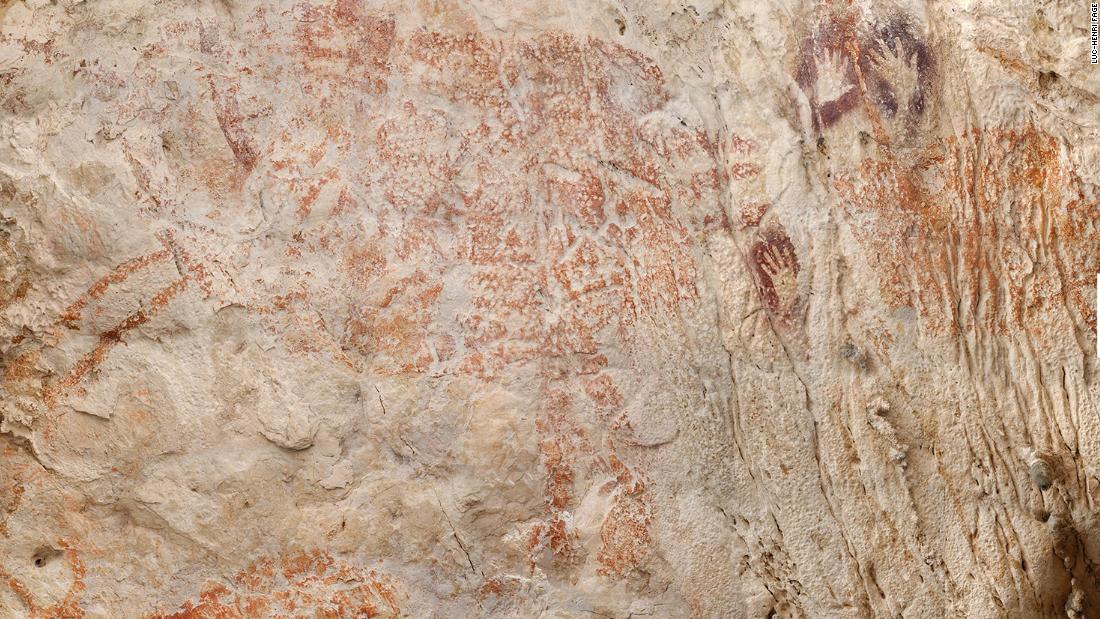
[ad_1]
The figurative painting is of wild cattle, part of a large panel with three large animal paintings. The pigment comes from iron oxide, or ocher, which gives the painting its reddish-orange hue.
Uranium dating of small samples of the limestone crust over the art dates to 40,000 years ago. The paintings were found in Borneo’s East Kalimantan province, where limestone caves contain thousands of rock art images. This particular painting, as well as many others, was found in the Lubang Jeriji Saléh cave.
Forty thousand years ago, Borneo was not an island but a part of continental Asia when the sea levels were lower, the researchers said.
The cave also contains hand stencils in the first ocher phase, a second phase of hand stencils in a mulberry color along with intricate motifs and humans, and a third phase of human figures, boats and geometric designs. The red-orange and purple pigments have an identical mineral composition, the researchers said, so they believe all of it was originally purple and shifted over time.
“We think the first phase of paintings focusing on red large animal paintings and hand stencils started between 40,000 and 52,000 years ago and possible lasted until the [ice age] 20,000 years ago,” Maxime Aubert, study author and associate professor at Griffith University in Australia, wrote in an email. “Then a second phase of rock art developed focusing on depicting the human world. We don’t know if these are from two different groups of humans or if it represents the evolution of a particular culture.”
The ice age artists in caves
This research team also discovered 35,000-year-old figurative animal cave art and 40,000-year-old hand stencils in Sulawesi, which lies between Asia and Australia.
Figurative art is a hallmark of this period in human history. “Figurative art developed in Southeast Asia at the same time as in Europe,” Aubert said. “The art also changes at about the same time. Initially humans made figurative painting of large animals and they later start depicting the human world.”
So what does this tell us about humans living in the area at the time? Although humans arrived in Southeast Asia between 60,000 and 70,000 years ago, there has been no art discovered that dates to that time. In Europe, the art appears at the same time modern humans arrived there.
This creates many theories. Perhaps the art just hasn’t been found or dated yet, or there were different waves of human migration — or the dates of the earliest arrivals of humans in Southeast Asia and Australia are wrong, Aubert said. Populations also could have boomed later, between 40,000 and 50,000 years ago.
Or maybe the art itself was “exported,” so to speak, traveling from place to place and beginning at different stages as humans learned art. This could account for the phases of art as well, from depicting animals to humans. Though human figures in rock art are common, they are rare in early art, Aubert said.
Climate could also be a factor, with the increase of art revealing times when the conditions were more favorable for humans, Aubert said. All of these are possible, but for right now, the artists themselves remain a mystery.
The treacherous trek to a cave
Although the paintings were found in 1994, researchers weren’t able to date them until now.
The paintings were high on the cave walls and ceiling, contrasting with the black drawings in the more accessible areas of the cave, Aubert said.
The discovery of calcite on top of the paintings was crucial because the researchers date when it formed, as opposed to the actual pigments. Calcite forms when rainwater seeps through limestone, dissolving a small amount of uranium. Uranium decays over time, creating the element thorium, and measuring the ratio of one element to the other reveals the age of the coating, Aubert said.
Reaching the cave art itself was treacherous, requiring the researchers to travel by canoe up a river, followed by walking for four days through dense jungle before hiking up a mountain. They travel light, sleeping in hammocks and staying in the cave for about two months. Their main water source is what drips from stalagmites, Aubert said.
The cave opens to an untouched valley ringing with the sounds of orangutans and bird calls, and the scent of durian fruit is heavy in the air. Tiger prints appear on the forest floor, as does the occasional cobra.
It is unknown whether there are human remains in the cave itself.
“We are planning archaeological excavation in those caves in order to find more information about these unknown artists,” Aubert said. That excavation will happen next year. “We also want to date more rock art in order to refine the minimum and maximum ages for each styles and also find out how long they lasted.”
The researchers will carry out those followup investigations in Borneo and Sulawesi.
But the cave art itself is a hugely important part of understanding ancient humans.
“It’s an intimate window into the past,” Aubert said. “Exactly, most of what we know about our deep past is from archaeological excavation and usually we found things that people left behind — essentially their trash. Rock art was made for a purpose and we can see how people lived a long time ago in a way that archaeology can’t provide. It’s also like they’re still talking to us today.”
Source link






